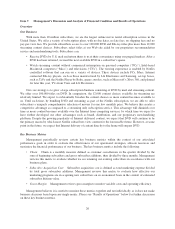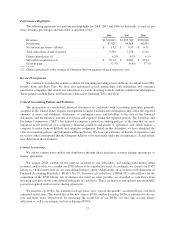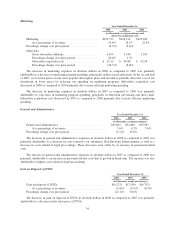NetFlix 2008 Annual Report Download - page 31
Download and view the complete annual report
Please find page 31 of the 2008 NetFlix annual report below. You can navigate through the pages in the report by either clicking on the pages listed below, or by using the keyword search tool below to find specific information within the annual report.Item 7. Management’s Discussion and Analysis of Financial Condition and Results of Operations
Overview
Our Business
With more than 10 million subscribers, we are the largest online movie rental subscription service in the
United States. We offer a variety of subscription plans, with no due dates, no late fees, no shipping fees and no
pay-per-view fees. We provide subscribers access to over 100,000 DVD and Blu-ray titles plus more than 12,000
streaming content choices. Subscribers select titles at our Web site aided by our proprietary recommendation
service and merchandising tools. Subscribers can:
• Receive DVDs by U.S. mail and return them to us at their convenience using our prepaid mailers. After a
DVD has been returned, we mail the next available DVD in a subscriber’s queue.
• Watch streaming content without commercial interruption on personal computers (“PCs”), Intel-based
Macintosh computers (“Macs”) and televisions (“TVs”). The viewing experience is enabled by Netflix
controlled software that can run on a variety of devices. These devices include PCs, Macs, Internet
connected Blu-ray players, such as those manufactured by LG Electronics and Samsung, set-top boxes,
such as TiVo and the Netflix Player by Roku, game consoles, such as Microsoft’s Xbox 360, and planned
for later this year, TVs from Vizio and LG Electronics.
Our core strategy is to grow a large subscription business consisting of DVD by mail and streaming content.
We offer over 100,000 titles on DVD. In comparison, the 12,000 content choices available for streaming are
relatively limited. We expect to substantially broaden the content choices as more content becomes available to
us. Until such time, by bundling DVD and streaming as part of the Netflix subscription, we are able to offer
subscribers a uniquely comprehensive selection of movies for one low monthly price. We believe this creates a
competitive advantage as compared to a streaming only subscription service. This advantage will diminish over
time as more content becomes available over the Internet from competing services, by which time we expect to
have further developed our other advantages such as brand, distribution, and our proprietary merchandising
platform. Despite the growing popularity of Internet delivered content, we expect that DVD will continue to be
the primary means by which most Netflix subscribers view content for the foreseeable future. However, at some
point in the future, we expect that Internet delivery of content directly to the home will surpass DVD.
Key Business Metrics
Management periodically reviews certain key business metrics within the context of our articulated
performance goals in order to evaluate the effectiveness of our operational strategies, allocate resources and
maximize the financial performance of our business. The key business metrics include the following:
•Churn: Churn is a monthly measure defined as customer cancellations in the quarter divided by the
sum of beginning subscribers and gross subscriber additions, then divided by three months. Management
reviews this metric to evaluate whether we are retaining our existing subscribers in accordance with our
business plans.
•Subscriber Acquisition Cost: Subscriber acquisition cost is defined as total marketing expense divided
by total gross subscriber additions. Management reviews this metric to evaluate how effective our
marketing programs are in acquiring new subscribers on an economical basis in the context of estimated
subscriber lifetime value.
•Gross Margin: Management reviews gross margin to monitor variable costs and operating efficiency.
Management believes it is useful to monitor these metrics together and not individually as it does not make
business decisions based upon any single metric. Please see “Results of Operations” below for further discussion
on these key business metrics.
26
























